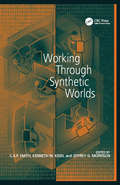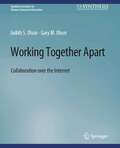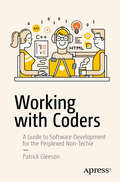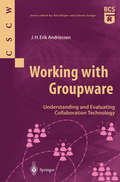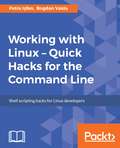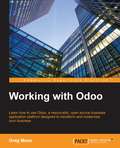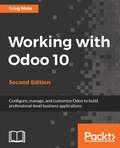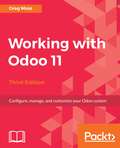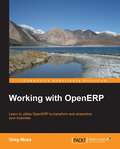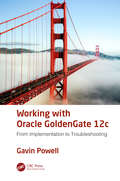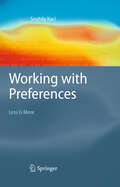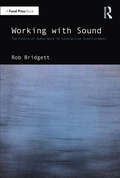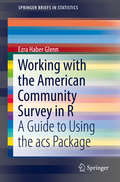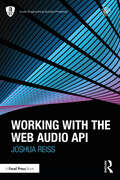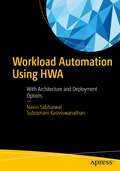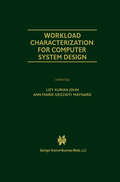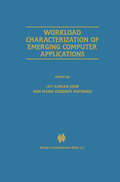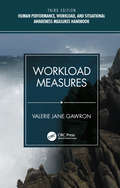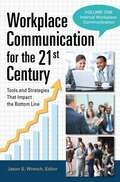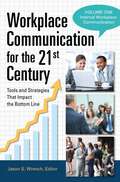- Table View
- List View
Working Through Synthetic Worlds
by Kenneth W. KisielVirtual environments (VE) are human-computer interfaces in which the computer creates a sensory-immersing environment that interactively responds to and is controlled by the behaviour of the user. Since these technologies will continue to become more reliable, more resolute and more affordable, it's important to consider the advantages that VEs may offer to support business processes. The term 'synthetic world' refers to a subset of VEs, having a large virtual landscape and a set of rules that govern the interactions among participants. Currently, the primary motivators for participation in these synthetic worlds appear to be fun and novelty. As the novelty wears off, synthetic worlds will need to demonstrate a favourable value proposition if they are to survive. In particular, non-game-oriented worlds will need to facilitate business processes to a degree that exceeds their substantial costs for development and maintenance. Working Through Synthetic Worlds explores a variety of different tasks that might benefit by being performed within a synthetic world. The editors use a distinctive format for the book, consisting of a set of chapters composed of three parts: ¢ a story or vignette that describes work conducted within a synthetic world based loosely on the question, 'what will work be like in the year 2025?', founded on the expert authors' expectations of plausible future technologies ¢ a scholarly review of the technologies described by the stories and the current theories related to those technologies ¢ a prescription for future research required to bridge the current state-of-the-art with the notional worlds described in the stories. The book will appeal to undergraduate and graduate students, professors, scientists and engineers, managers in high-tech industries and software developers.
Working Through Synthetic Worlds
by Kenneth W. KisielVirtual environments (VE) are human-computer interfaces in which the computer creates a sensory-immersing environment that interactively responds to and is controlled by the behaviour of the user. Since these technologies will continue to become more reliable, more resolute and more affordable, it's important to consider the advantages that VEs may offer to support business processes. The term 'synthetic world' refers to a subset of VEs, having a large virtual landscape and a set of rules that govern the interactions among participants. Currently, the primary motivators for participation in these synthetic worlds appear to be fun and novelty. As the novelty wears off, synthetic worlds will need to demonstrate a favourable value proposition if they are to survive. In particular, non-game-oriented worlds will need to facilitate business processes to a degree that exceeds their substantial costs for development and maintenance. Working Through Synthetic Worlds explores a variety of different tasks that might benefit by being performed within a synthetic world. The editors use a distinctive format for the book, consisting of a set of chapters composed of three parts: ¢ a story or vignette that describes work conducted within a synthetic world based loosely on the question, 'what will work be like in the year 2025?', founded on the expert authors' expectations of plausible future technologies ¢ a scholarly review of the technologies described by the stories and the current theories related to those technologies ¢ a prescription for future research required to bridge the current state-of-the-art with the notional worlds described in the stories. The book will appeal to undergraduate and graduate students, professors, scientists and engineers, managers in high-tech industries and software developers.
Working Together Apart: Collaboration over the Internet (Synthesis Lectures on Human-Centered Informatics)
by Judy Olson Gary OlsonIncreasingly, teams are working together when they are not in the same location, even though there are many challenges to doing so successfully. Here we review the latest insights into these matters, guided by a framework that we have developed during two decades of research on this topic. This framework organizes a series of factors that we have found to differentiate between successful and unsuccessful distributed collaborations. We then review the kinds of technology options that are available today, focusing more on types of technologies rather than specific instances. We describe a database of geographically distributed projects we have studied and introduce the Collaboration Success Wizard, an online tool for assessing past, present, or planned distributed collaborations. We close with a set of recommendations for individuals, managers, and those higher in the organizations who wish to support distance work.
Working with Coders: A Guide to Software Development for the Perplexed Non-Techie
by Patrick GleesonGet introduced to the fascinating world inhabited by the professional software developer. Aimed at a non-technical audience, this book aims to de-obfuscate the jargon, explain the various activities that coders undertake, and analyze the specific pressures, priorities, and preoccupations that developers are prone to. In each case it offers pragmatic advice on how to use this knowledge to make effective business decisions and work productively with software teams.Software projects are, all too often, utter nightmares for everyone involved. Depending on which study you read, between 60 and 90 percent of all software projects are completed late, run over budget, or deliver an inferior quality end product. This blight affects everyone from large organizations trying to roll out business change to tiny startups desperately trying to launch their MVP before the money runs out. While there has been much attention devoted to understanding these failings, leading to the development of entire management methodologies aimed at reducing the failure rate, such new processes have had, at best, limited success in delivering better results. Based on a decade spent exploring the world of software, Patrick Gleeson argues that the underlying reason for the high failure rate of software projects is that software development, being a deeply arcane and idiosyncratic process, tends to be thoroughly and disastrously misunderstood by managers and leaders. So long as the people tasked with making decisions about software projects are unaware of these idiosyncrasies and their ramifications, software projects will be delivered late, software products will be unfit for purpose, and relations between software developers and their non-technical colleagues will be strained. Even the most potent modern management tools are ineffective when wielded blindly.To anyone who employs, contracts, manages, or works with software developers, Working with Coders: A Guide to Software Development for the Perplexed Non-Techie delivers the understanding necessary to reduce friction and inefficiencies at the intersection between software development teams and their non-technical colleagues.What You'll LearnDiscover why software projects are so commonly delivered late and with an abysmal end productExamine why the relationship between coders and their non-technical colleagues is often strainedUnderstand how the software development process works and how to support it effectivelyDecipher and use the jargon of software developmentKeep a team of coders happy and improve the odds of successful software project deliveryWho This Book Is ForAnyone who employs, contracts, or manages software developers—such as tech startup CEOs, project managers, and clients of digital agencies—and wishes the relationship were easier and more productive. The secondary readership is software developers who want to find ways of working more effectively as part of a team.
Working with Groupware: Understanding and Evaluating Collaboration Technology (Computer Supported Cooperative Work)
by J.H. Erik AndriessenGroupware is a technology designed to help people working in groups to communicate their ideas more easily. While traditional technologies such as the telephone qualify as groupware, the term is usually used to refer to a specific class of technologies that rely on modern computer networks, such as email, newsgroups and videophones. Working with Groupware introduces the basic concepts and brings together ideas from various disciplines to provide an integrated approach to the evaluation and design of groupware technology. Key features include an analysis of the successes and failures of collaborative technology.
Working with Linux – Quick Hacks for the Command Line
by Petru I Fan Bogdan Vaida 5 30 2017Say goodbye to unproductive Linux habits and switch to the express laneAbout This BookImprove your terminal and command-line productivity by using powerful toolsSharpen your existing command-line skills and achieve complex tasks fasterSave time and money by creating customized commands that automate day-to-day tasksWho This Book Is ForThis book is for system administrators and developers who know the basics of Linux and want to brush up and sharpen their skills. Prior experience with Linux shell is required.What You Will LearnOptimize the power of Guake by integrating it with ClipItDeep dive into the workings of the console editor—VimExplore the advanced concepts and best practices of shell scriptingEdit large amounts of data quickly using SedUse pipes and subshells to create customized commandsGet to know how you can speed up the software development and make the terminal a handy companionIn DetailWebsites, online services, databases, and pretty much every other computer that offers public services runs on Linux. From small servers to clusters, Linux is anywhere and everywhere. With such a broad usage, the demand for Linux specialists is ever growing. For the engineers out there, this means being able to develop, interconnect, and maintain Linux environments.This book will help you increase your terminal productivity by using Terminator, Guake and other tools. It will start by installing Ubuntu and will explore tools and techniques that will help you to achieve more work with less effort. Next, it will then focus on Terminator, the ultimate terminal, and vim, one of the most intelligent console editors. Futhermore, the readers will see how they can increase their command line productivity by using sed, find, tmux, network, autoenv. The readers will also see how they can edit files without leaving the terminal and use the screen space efficiently and copy-paste like a pro. Towards the end, we focus on network settings, Git hacks, and creating portable environments for development and production using Docker.Through this book, you will improve your terminal productivity by seeing how to use different tools.Style and ApproachThis book takes a step-by-step approach using examples that show you how to automate tasks using terminal commands. You'll work through easy-to-follow instructions so you learn to use the various Linux commands and tools such as Terminator, Guake, and others.
Working with Odoo
by Greg MossLearn how to use Odoo, a resourceful, open source business application platform designed to transform and modernize your business About This Book • Configure, manage, and customize Odoo to fit the needs of your business • Learn about the new Odoo 8 website builder and e-commerce features that are seamlessly integrated with Odoo's business applications • Perform step-by-step configurations of the most important Odoo applications using real-world examples Who This Book Is For This book is perfect for people who have never used Odoo and for those who would like to learn about more advanced features such as creating your own custom modules. In order to get the most out of this book, you should be comfortable with downloading and installing software and understand basic business concepts such as sales, purchasing, inventory management, and basic accounting. What You Will Learn • Configure a functioning customer relationship management system • Set up a purchasing and receiving system for your company that allows you to track inventory, costs, and profit • Implement manufacturing operations and processes using real-world examples that you can put to use in your own company • Discover the capabilities of Odoo's financial accounting and reporting features • Integrate powerful human resource applications that simplify the collection and management of employee information • Utilize Odoo's full featured project management application to organize tasks and track time and costs associated with billable projects • Customize Odoo without writing a line a code In Detail Odoo continues to gain momentum throughout the world in regards to providing the best platform for open source ERP installations. Now with Odoo 8, you have access to a powerful website builder, integrated e-commerce features, and a fast-growing community to help transform and modernize your business. With this practical guide, you will cover the essential modules to get Odoo up and running for your company. After installing Odoo, you will use its sales management application to enter quotes, create sales orders, and invoice customers. You will then learn how to integrate the CRM application to manage your leads and convert them into lucrative opportunities and sales. Next, you will set up your own purchase management system, assigning products to suppliers and tracking orders with the new warehouse management and routing system. Finally, you will learn how to use analytics to track project expenses and keep your accounts simple and easy to maintain and build an Odoo module to extend its functionality and make it work for you. Working with Odoo covers all the core installation and usage functionalities of this popular tool, helping you to fully implement a working ERP system through practical, advanced, real-world examples. Style and approach This book is a practical guide that uses real-world examples to teach you how to implement Odoo into your business.
Working with Odoo 10 - Second Edition
by Greg MossConfigure, manage, and customize Odoo to build professional-level business applications About This Book • Build an Odoo module and integrate it with other platforms through this practical guide • This book is the perfect companion to help you customize your Odoo installations for your enterprise requirements • Use project management along with analytics for better reporting Who This Book Is For This book is for those who have not used Odoo before, allowing you to learn advanced-level features with Odoo such as creating your own custom modules. You do not need any knowledge of Odoo. What You Will Learn • Configure a functioning customer relationship management system • Set up a purchasing and receiving system • Implement manufacturing operations and processes using real-world examples • Discover the capabilities of Odoo's financial accounting and reporting features • Integrate powerful human resource applications • Utilize Odoo's project management application to organize tasks • Customize Odoo without writing a line a code In Detail Odoo is a comprehensive set of open-source enterprise management applications. Now with Odoo 10, you have access to a powerful website builder, integrated e-commerce features, and a fast-growing community to help transform and modernize your business. You will start with how to set up Odoo online and on your own server. You'll then configure the basic company settings required to quickly getting your first Odoo system up and running. Later you'll explore Customer Relationship Management in Odoo and and their importance in today's modern business environment. Next we will deep dive into purchasing application with Odoo and learn some of the primary functionalities of ERP systems for manufacturing operations. You will then use analytic accounting to provide better reporting. Finally you will walk through the recent Odoo 10 features with respect to the community and enterprise edition giving you complete understanding of what Odoo can do for you no matter the reason! Style and approach This fast-paced, step-by-step guide will show you everything you need to know about the Odoo module ecosystem through practical and real-world examples.
Working with Odoo 11: Configure, Manage, And Customize Your Odoo System, 3rd Edition
by Greg MossOdoo is an all-in-one management software that offers a range of business applications that form a complete suite of enterprise management applications. Odoo 11 comes with advances made on Usability, Speed, Design, and Mobile.
Working with OpenERP
by Gregory MossThis book is a practical, hands-on guide that provides the reader with a number of real-world examples and step-by-step instructions."Working with OpenERP" is written to make it easy for even a non-technical business person to begin implementing OpenERP in their business. This book uses real-world examples and is perfect for people who have never implemented an ERP system before or used OpenERP, or for those who would like to learn more advanced features, such as creating your own custom modules.
Working with Oracle GoldenGate 12c: From Implementation to Troubleshooting
by Gavin PowellThis book teaches the basics of Oracle GoldenGate, which is a product that is used to simplify the process of Oracle Database Replication. GoldenGate can be used for reporting, failover, high availability, live reporting, data warehousing, and BigData ETL process, as well as connecting to multiple other data sources outside of Oracle Database such as SQL Server, MySQL, Teradata, PostgreSQL, and many others. The purpose of GoldenGate and its popularity is its ability to make the highly complex architecture of database replication into a much more simplistic task. This book teaches the reader how to use Oracle GoldenGate, from installation to troubleshooting.
Working with Oracle GoldenGate 12c: From Implementation to Troubleshooting
by Gavin PowellThis book teaches the basics of Oracle GoldenGate, which is a product that is used to simplify the process of Oracle Database Replication. GoldenGate can be used for reporting, failover, high availability, live reporting, data warehousing, and BigData ETL process, as well as connecting to multiple other data sources outside of Oracle Database such as SQL Server, MySQL, Teradata, PostgreSQL, and many others. The purpose of GoldenGate and its popularity is its ability to make the highly complex architecture of database replication into a much more simplistic task. This book teaches the reader how to use Oracle GoldenGate, from installation to troubleshooting.
Working with Preferences: Less Is More (Cognitive Technologies)
by Souhila KaciPreferences are useful in many real-life problems, guiding human decision making from early childhood up to complex professional and organizational decisions. In artificial intelligence specifically, preferences is a relatively new topic of relevance to nonmonotonic reasoning, multiagent systems, constraint satisfaction, decision making, social choice theory and decision-theoretic planning The first part of this book deals with preference representation, with specific chapters dedicated to representation languages, nonmonotonic logics of preferences, conditional preference networks, positive and negative preferences, and the study of preferences in cognitive psychology. The second part of the book deals with reasoning with preferences, and includes chapters dedicated to preference-based argumentation, preferences database queries, and rank-ordering outcomes and intervals. The author concludes by examining forthcoming research perspectives. This is inherently a multidisciplinary topic and this book will be of interest to computer scientists, economists, operations researchers, mathematicians, logicians, philosophers and psychologists.
Working with Sound: The Future of Audio Work in Interactive Entertainment
by Rob BridgettWorking with Sound is an exploration of the ever-changing working practices of audio development in the era of hybrid collaboration in the games industry. Through learnings from the pre-pandemic remote and isolated worlds of audio work, sound designers, composers, and dialogue designers find themselves equipped uniquely to thrive in the hybrid, remote, and studio-based realms of today’s fast-evolving working landscapes. With unique insights into navigating the worlds of isolation and collaboration, this book explores ways of thinking and working in this world, equipping the reader with inspiration to sustainably tackle the many stages of the development process. Working with Sound is an essential guide for professionals working in dynamic audio teams of all sizes, as well as the designers, producers, artists, animators, and programmers who collaborate closely with their colleagues working on game audio and sound.
Working with Sound: The Future of Audio Work in Interactive Entertainment
by Rob BridgettWorking with Sound is an exploration of the ever-changing working practices of audio development in the era of hybrid collaboration in the games industry. Through learnings from the pre-pandemic remote and isolated worlds of audio work, sound designers, composers, and dialogue designers find themselves equipped uniquely to thrive in the hybrid, remote, and studio-based realms of today’s fast-evolving working landscapes. With unique insights into navigating the worlds of isolation and collaboration, this book explores ways of thinking and working in this world, equipping the reader with inspiration to sustainably tackle the many stages of the development process. Working with Sound is an essential guide for professionals working in dynamic audio teams of all sizes, as well as the designers, producers, artists, animators, and programmers who collaborate closely with their colleagues working on game audio and sound.
Working with the American Community Survey in R: A Guide to Using the acs Package (SpringerBriefs in Statistics)
by Ezra Haber GlennThis book serves as a hands-on guide to the "acs" R package for demographers, planners, and other researchers who work with American Community Survey (ACS) data. It gathers the most common problems associated with using ACS data and implements functions as a package in the R statistical programming language. The package defines a new "acs" class object (containing estimates, standard errors, and metadata for tables from the ACS) with methods to deal appropriately with common tasks (e.g., creating and combining subgroups or geographies, automatic fetching of data via the Census API, mathematical operations on estimates, tests of significance, plots of confidence intervals).
Working with the Web Audio API (Audio Engineering Society Presents)
by Joshua ReissWorking with the Web Audio API is the definitive and instructive guide to understanding and using the Web Audio API. The Web Audio API provides a powerful and versatile system for controlling audio on the Web. It allows developers to generate sounds, select sources, add effects, create visualizations and render audio scenes in an immersive environment. This book covers all essential features, with easy to implement code examples for every aspect. All the theory behind it is explained, so that one can understand the design choices as well as the core audio processing concepts. Advanced concepts are also covered, so that the reader will gain the skills to build complex audio applications running in the browser. Aimed at a wide audience of potential students, researchers and coders, this is a comprehensive guide to the functionality of this industry-standard tool for creating audio applications for the web.
Working with the Web Audio API (Audio Engineering Society Presents)
by Joshua ReissWorking with the Web Audio API is the definitive and instructive guide to understanding and using the Web Audio API. The Web Audio API provides a powerful and versatile system for controlling audio on the Web. It allows developers to generate sounds, select sources, add effects, create visualizations and render audio scenes in an immersive environment. This book covers all essential features, with easy to implement code examples for every aspect. All the theory behind it is explained, so that one can understand the design choices as well as the core audio processing concepts. Advanced concepts are also covered, so that the reader will gain the skills to build complex audio applications running in the browser. Aimed at a wide audience of potential students, researchers and coders, this is a comprehensive guide to the functionality of this industry-standard tool for creating audio applications for the web.
Workload Automation Using HWA: With Architecture and Deployment Options
by Navin Sabharwal Subramani KasiviswanathanApply best practices for deploying and administering HCL Workload automation (HWA) to meet the automation requirements of the digitally transformed platform. This book will provide detailed architecture and deployment options to achieve this goal.Workload automation focuses on real-time processing, predefined event-driven triggers, and situational dependencies. It offers centralized control of managing multiple tasks, making it possible to schedule enterprise-wide tasks. You'll see how it supports the timely completion of tasks and is beneficial for processes that need to happen at a specific time or need to occur as a result of another event. HWA increases efficiency, reduces the turnaround time for workflows, and reduces errors along with delays in end-to-end processes. You'll review proven ways to deliver batch optimization and modernization requirements, and see how solutions can be aligned with the DevSecOps delivery model. Workload Automation Using HWA presents information on how to use the tool and has numerous use cases and implementation procedures to guide every workload automation deployment requirement. What You'll LearnAutomate and integrate your complex workload, workflow, and business processes across automation platforms, ERP systems, and business applicationsUnderstand event-driven batch automationPractice alignment of the workload automation solution with the DevSecOps principlesWho This Book Is ForSolution Architects, Infrastructure Architects, Technical Architects, Enterprise Architects, Workload Automation Tool Administrators or SME’s, Schedulers, Application owners, Automation Specialists, Service Delivery Managers
Workload Characterization for Computer System Design (The Springer International Series in Engineering and Computer Science #542)
by Ann Marie GrizzaffiMaynard Lizy KurianJohnThe advent of the world-wide web and web-based applications have dramatically changed the nature of computer applications. Computer system design, in the light of these changes, involves understanding these modem workloads, identifying bottlenecks during their execution, and appropriately tailoring microprocessors, memory systems, and the overall system to minimize bottlenecks. This book contains ten chapters dealing with several contemporary programming paradigms including Java, web server and database workloads. The first two chapters concentrate on Java. While Barisone et al.'s characterization in Chapter 1 deals with instruction set usage of Java applications, Kim et al.'s analysis in Chapter 2 focuses on memory referencing behavior of Java workloads. Several applications including the SPECjvm98 suite are studied using interpreter and Just-In-Time (TIT) compilers. Barisone et al.'s work includes an analytical model to compute the utilization of various functional units. Kim et al. present information on locality, live-range of objects, object lifetime distribution, etc. Studying database workloads has been a challenge to research groups, due to the difficulty in accessing standard benchmarks. Configuring hardware and software for database benchmarks such as those from the Transactions Processing Council (TPC) requires extensive effort. In Chapter 3, Keeton and Patterson present a simplified workload (microbenchmark) that approximates the characteristics of complex standardized benchmarks.
Workload Characterization of Emerging Computer Applications (The Springer International Series in Engineering and Computer Science #610)
by Lizy Kurian John Ann Marie Grizzaffi MaynardThe formal study of program behavior has become an essential ingredient in guiding the design of new computer architectures. Accurate characterization of applications leads to efficient design of high performing architectures. Quantitative and analytical characterization of workloads is important to understand and exploit the interesting features of workloads. This book includes ten chapters on various aspects of workload characterizati on. File caching characteristics of the industry-standard web-serving benchmark SPECweb99 are presented by Keller et al. in Chapter 1, while value locality of SPECJVM98 benchmarks are characterized by Rychlik et al. in Chapter 2. SPECJVM98 benchmarks are visited again in Chapter 3, where Tao et al. study the operating system activity in Java programs. In Chapter 4, KleinOsowski et al. describe how the SPEC2000 CPU benchmark suite may be adapted for computer architecture research and present the small, representative input data sets they created to reduce simulation time without compromising on accuracy. Their research has been recognized by the Standard Performance Evaluation Corporation (SPEC) and is listed on the official SPEC website, http://www. spec. org/osg/cpu2000/research/umnl. The main contribution of Chapter 5 is the proposal of a new measure called locality surface to characterize locality of reference in programs. Sorenson et al. describe how a three-dimensional surface can be used to represent both of programs. In Chapter 6, Thornock et al.
Workload Measures
by Valerie Jane GawronThis book was developed to help researchers and practitioners select measures to be used in the evaluation of human/machine systems. The book includes definitions of human workload and a review of measures. Each measure is described, along with its strengths and limitations, data requirements, threshold values, and sources of further information. To make this reference easier to use, extensive author and subject indices are provided. Features Offers readily accessible information on workload measures Presents general description of the measure Covers data collection, reduction, and analysis requirements Details the strengths and limitations or restrictions of each measure, including proprietary rights or restrictions Provides validity and reliability data as available
Workload Measures
by Valerie Jane GawronThis book was developed to help researchers and practitioners select measures to be used in the evaluation of human/machine systems. The book includes definitions of human workload and a review of measures. Each measure is described, along with its strengths and limitations, data requirements, threshold values, and sources of further information. To make this reference easier to use, extensive author and subject indices are provided. Features Offers readily accessible information on workload measures Presents general description of the measure Covers data collection, reduction, and analysis requirements Details the strengths and limitations or restrictions of each measure, including proprietary rights or restrictions Provides validity and reliability data as available
Workplace Communication for the 21st Century [2 volumes]: Tools and Strategies That Impact the Bottom Line [2 volumes]
by Jason S. WrenchWritten in clear, non-technical language, this book explains how employees and employers can maximize internal and external organizational communication—for both personal benefit and to the entity as a whole.Workplace Communication for the 21st Century: Tools and Strategies That Impact the Bottom Line explains and simplifies what organizational communication scholars have learned, presenting this knowledge so that it can be easily applied to generate tangible benefits to employees and employers as they face everyday challenges in the real world.This two-volume work discusses internal organizational and external organizational communication separately, first explaining how communication functions within the confines of a modern organization, then addressing how organizations interact with various stakeholders, such as customers, clients, and regulatory agencies. The expert contributors provide a thorough and insightful view on organizational communication and supply a range of strategies that will be useful to practitioners and academics alike.
Workplace Communication for the 21st Century [2 volumes]: Tools and Strategies That Impact the Bottom Line [2 volumes]
by Jason S. WrenchWritten in clear, non-technical language, this book explains how employees and employers can maximize internal and external organizational communication—for both personal benefit and to the entity as a whole.Workplace Communication for the 21st Century: Tools and Strategies That Impact the Bottom Line explains and simplifies what organizational communication scholars have learned, presenting this knowledge so that it can be easily applied to generate tangible benefits to employees and employers as they face everyday challenges in the real world.This two-volume work discusses internal organizational and external organizational communication separately, first explaining how communication functions within the confines of a modern organization, then addressing how organizations interact with various stakeholders, such as customers, clients, and regulatory agencies. The expert contributors provide a thorough and insightful view on organizational communication and supply a range of strategies that will be useful to practitioners and academics alike.
